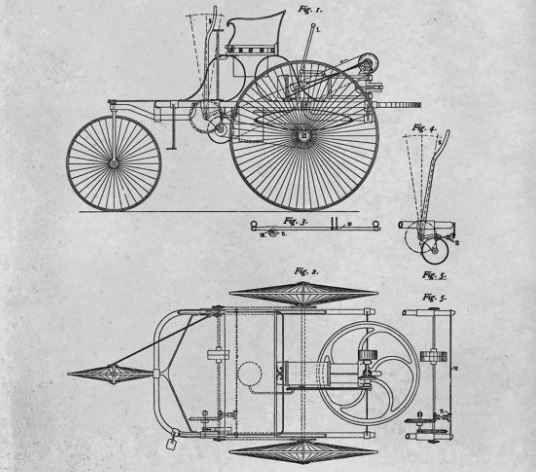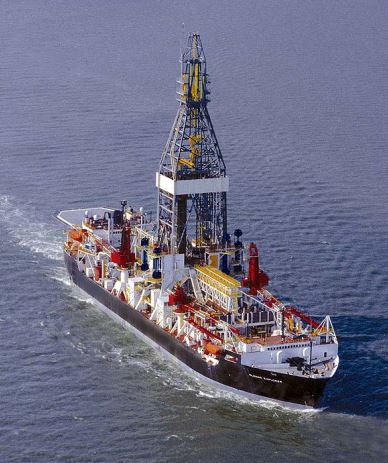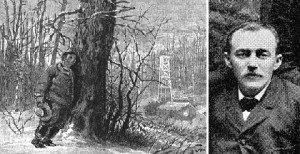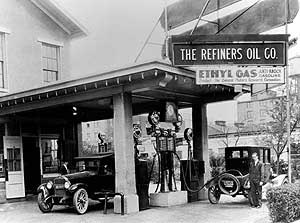January 29, 1850 – Kerosene Inventor patents Gasification Process –
Canadian geologist Abraham Gessner received a U.S. patent for a gas manufacturing process, “to enable others skilled in the art…for obtaining of illuminating gas from compact and fluid bitumen (crude oil), asphaltum, chapapote, or mineral pitch as found in mines, quarries and springs in the earth.”
Gessner licensed his “coal gas” distillation apparatus (patent no. 7052) for about $1 per burner, declaring his manufactured gas “affords the cleanest, safest, and most agreeable light ever used.” By 1854, Gessner’s research would lead him to invent another illuminating fuel, “a new liquid hydrocarbon, which I denominate Kerosene.”
January 29, 1886 – Karl Benz applies to Patent First Gasoline Powered Auto
German mechanical engineer Karl Benz applied for a Reich Patent (no. 34735) for his Benz motorwagen, a three-wheeler with a one-cylinder, four-stroke gasoline engine. His innovative “Fahrzeug mit Gasmotorenbetrieb” (vehicle with gas engine operation) was the world’s first patent for a practical internal combustion engine powered car.

Detail from “vehicle with gas engine operation,” patent No. 37435, submitted by Karl Benz on January 29, 1884, at the Reich Patent Office in Berlin.
Although there had already been “auto-mobiles” powered by steam or electricity, Benz used the internal combustion engine as the drive system. The Imperial Patent Office 1886 Benz patent has been called the birth certificate of the automobile.
In August 1888, his wife Bertha would drive a Benz motorwagen from Mannheim to Pforzheim in a headline-making publicity stunt (see First Car, First Road Trip).
January 30, 1998 – Spy Ship relaunched as Ultra-Deep Drill Ship
Decades after secretly recovering parts of a lost Soviet ballistic missile submarine, and after a $180 million shipyard conversion, the Glomar Explorer began its career as a record-setting, deep-water drill ship for the offshore petroleum industry.

Glomar Explorer in 1998 began a record-setting career as a high-tech deep water drill ship. Photo courtesy American Society of Mechanical Engineers.
Launched by Global Marine Drilling with a long-term lease of $1 million per year from the U.S. Navy, the world’s largest drill ship would spend 17 years drilling ultra-deep wells around the world. The pioneering vessel began its career in 1972 as the Hughes Glomar Explorer, designed and built for the CIA’s “Project Azorian” to raise submarine K-129 from more than three miles deep.
Learn more in Secret History of Drill Ship Glomar Explorer.
January 31, 1888 – Death of a Famed Pennsylvania Oil Scout
Thirty-seven-year-old Justus McMullen, already a famous Pennsylvania oil scout, succumbed to pneumonia contracted while investigating production data from a well near Canonsburg, southwest of Pittsburgh.

Oil scouts like Justus McMullen of Bradford, Pennsylvania, braved harsh winters to gather intelligence about oil wells.
McMullen, an oilfield detective who published the Bradford “Petroleum Age” newspaper, contributed much to the early U.S. oil exploration and production industry. Sometimes called “night riders of the hemlocks,” oilfield scouts debunked rumors and demystified oil well production reports — sometimes despite armed guards.
Learn more in Oil Scouts – Oil Patch Detectives.
January 31, 1946 – Houston Petroleum Club founded
Texas independent producers founded the Petroleum Club of Houston. The group began meeting on the top floor of the Rice Hotel in downtown Houston in 1951. Club members hosted industry events and lunchtime business meetings where deals were made with a handshake. One wall featured a 21-foot tapestry of a geological cross-section of Texas.

Founded in 1946, the Petroleum Club of Houston began meeting at the Rice Hotel in 1951.
The Houston Petroleum Club moved to the ExxonMobil Building in 1963 and occupied 45,000 square feet on floors 43 and 44 before moving into the top floor of nearby Total Plaza in 2015.
February 1, 1868 – Oil Quality weighed for Pricing
For the first time, crude oil price quotations began to be based on specific gravity — the heaviness of a substance compared to that of water. In the new oil regions of Pennsylvania, independent producers frequently met to sell shares of stock, argue prices and enter into refining contracts that depended on the oil’s quality.
Before establishment of the Titusville Oil Exchange, in 1871, producers often gathered along Centre Street in Oil City, known as the “Curbside Exchange.” In 1921, the American Petroleum Institute established API gravity, which would become the worldwide standard. Crude oil can be classified as light, medium, or heavy, according to its measured gravity.
February 2, 1923 – First Anti-Knock Gas goes on Sale
The world’s first anti-knock gasoline containing a tetra-ethyl lead compound went on sale at the Refiners Oil Company service station in Dayton, Ohio. Discovered two years earlier by General Motors scientists, “Ethyl” vastly improved engine performance. The company began providing service stations with bolt-on adapters called “Ethylizers” to meter the proper proportion of the new additive.

“Ethyl” gasoline goes on sale for the first time at this Refiners Oil Company service station in Dayton, Ohio. Photo courtesy Kettering/GMI Alumni Foundation.
“By the middle of this summer you will be able to purchase at approximately 30,000 filling stations in various parts of the country, a fluid that will double the efficiency of your automobile, eliminate the troublesome motor knock, and give you 100 percent greater mileage,” Popular Science Monthly reported in 1924 (see Ethyl Anti-Knock Gas). The toxicity of tetra-ethyl lead resulted in a federally mandated phase out of the additive beginning in 1976.
February 3, 1868 – Refiners seek End Civil to War Tax
Angry refiners from Oil Creek, Pennsylvania, met in Petroleum Center and passed a resolution demanding an end to the “war tax” of one dollar per 42-gallon barrel of refined petroleum products, including kerosene. During the Civil War, Treasury Secretary Salmon P. Chase had advocated taxes as high as $10.50 per barrel. The one-dollar excise tax was imposed in 1864.
February 4, 1910 – Famed Showman “Buffalo Bill” explored for Wyoming Oil
Col. William F. “Buffalo Bill” Cody’s legacy extended beyond his famous Wild West Show, reaching into the Wyoming oil patch. Cody, who in 1896 founded the town that bears his name, in February 1910 bought 7,500 shares of an exploration venture he had formed with a congressman. It was not their first attempt to strike oil.

W.F. “Buffalo Bill” Cody, center in black hat, and other investors at an oilfield on the Shoshone Anticline near Cody, Wyoming, around 1910. Photo courtesy the American Heritage Center, University of Wyoming.
In 1902, Cody and several partners, including Wyoming Rep. Frank Mondell, had begun exploring near Cody. They drilled one 500-foot-deep dry hole and a second well also failed to find oil before they ran out of money. Cody and the congressman ventured into the oil business again in 1910 by forming the Shoshone Oil Company.
During a visit to New York City, Cody carried pocket flasks of oil to impress investors. His friends started calling him, “Bill the Oil King,” noted one historian, adding, “with what degree of seriousness we cannot know.”
Learn more in Buffalo Bill Shoshone Oil Company.
February 4, 1920 – Breckenridge Field joins North Texas Oil Boom
The No. 1 Chaney well tapped another giant oilfield in North Texas, which three years earlier had made headlines for its “Roaring Ranger” well in Eastland County. The latest discovery within the city limits of Breckenridge in Stephens County produced 3,700 barrels of oil per day.
“This started an intensive town block drilling campaign, and soon every block had its oil rig. Over 200 wells were drilled on the townsite, and most of them were good producers,” noted a 1930 report. “Owners of very small plots were made wealthy. By 1923, over 2,000 derricks surrounded Breckenridge within a radius of four miles.”
As the North Texas drilling boom continued, Breckenridge acquired its first railroad connection to Wichita Falls, Ranger and Fort Worth, soon joined by the Cisco and Northeastern line (see Oil Boom Brings First Hilton Hotel).
_______________________
Recommended Reading: Bertha Takes a Drive: How the Benz Automobile Changed the World (2017); Project Azorian: The CIA and the Raising of the K-129 (2012); The Oil Scouts – Reminiscences of the Night Riders of the Hemlocks
(1986); The Finest in the Land: The Story of the Petroleum Club of Houston
(1984); Unleaded: How Changing Our Gasoline Changed Everything (2021); Western Pennsylvania’s Oil Heritage
(2008); Presenting Buffalo Bill: The Man Who Invented the Wild West
(2016). Your Amazon purchase benefits the American Oil & Gas Historical Society. As an Amazon Associate, AOGHS earns a commission from qualifying purchases.
_______________________
The American Oil & Gas Historical Society (AOGHS) preserves U.S. petroleum history. Become an AOGHS annual supporting member and help maintain this energy education website and expand historical research. For more information, contact bawells@aoghs.org. Copyright © 2024 Bruce A. Wells. All rights reserved.


